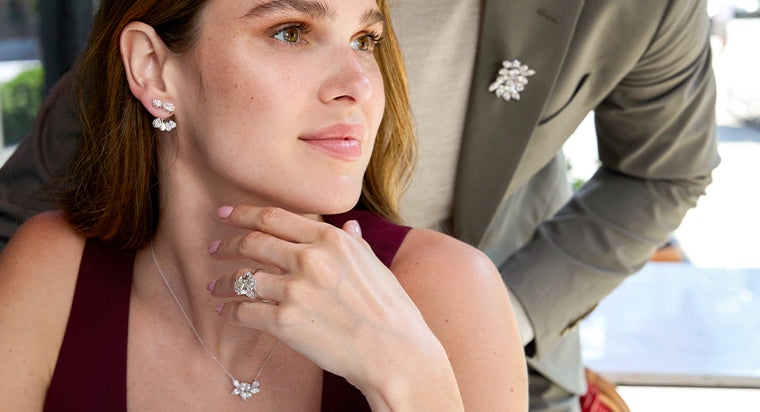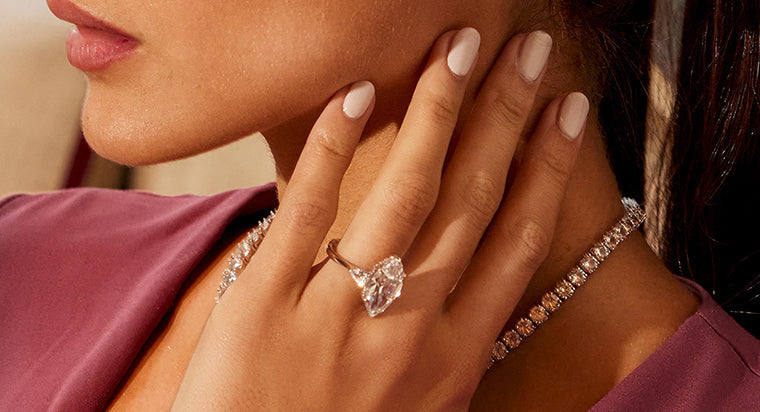Buying Guide for Pear Engagement Rings

If you're on the lookout for a non-traditional and unique engagement ring, then a pear-cut diamond engagement ring is a stunning choice. Timeless, elegant, and eye-catching, this cut is anything but typical, so it stands out (in a good way!).
We've created a buying guide to help you understand pear-cut diamonds and find the perfect one for your engagement ring.
TABLE OF CONTENTS
All About Pear-Cut Diamonds
Pear diamonds (also known as teardrop diamonds) are brilliant and a versatile choice. They’re a hybrid cut that combines the brilliance of round diamonds with the elongated silhouette of marquise, resulting in a sparkling diamond that’s rounded on one end and has a pointed tip on the other.
Their shape has a lengthening effect on the finger, so if you love that elegant, slender look, the pear cut is a winner. They’re also incredibly versatile—they can be worn with the tip pointing up or down, depending on the look you love. Plus, pears look bigger per carat when compared to other diamond cuts. If you're looking for an engagement ring that blends brilliance with a unique character, a pear-cut diamond is the way to go.
Why Pear-Cut Engagement Rings Are So Popular Today
Pear-cut engagement rings have surged in popularity in recent years because they strike the perfect balance between individuality and timelessness. While brides still want a diamond that sparkles, many are looking for a shape that feels a little different — something that stands out without straying too far from tradition—and the pear cut does precisely that.
Social media and celebrity influence have also propelled the pear cut into the spotlight. Famous pear-cut engagement rings include Margot Robbie’s striking 1.5-carat diamond ring, Cardi B’s impressive 8-carat sparkler, and Victoria Beckham’s one of many jaw-dropping engagement rings.
Inspired by celebrities and trends, brides around the world are following the suit. Add in the fact that pear shapes adapt seamlessly to any setting - from modern solitaires and glamorous halos to charming vintage styles, it’s easy to see why this cut has become such a sought-after choice.
Pear Diamond: Pros and Cons
Pear diamonds have a lot going for them—they’re elegant, unique, and full of symbolism (the teardrop shape is often seen as a symbol of love, emotion, and new beginnings).
First, let’s look at the pros:
- Brilliant Sparkle: Pear-cut diamonds have 58 facets, just like the round-cut, meaning they can deliver nearly the same fire and scintillation. If maximum sparkle is what you’re after, the pear diamond delivers.
- Graceful and unique: With their rounded curve and pointed tip, pear-cut diamonds have a charming look that’s unconventional yet undeniably elegant. They simply stand out!
- Flattering Shape: Its elongated design creates the illusion of longer, slender fingers — a big reason brides love this cut.
- Affordable: Pears don’t just look bigger than round diamonds of the same carat weight; they also cost less. This is because a rough diamond is wasted during the cutting process, and the prices aren’t as heavily marked up by demand.
Now, let’s look at the cons:
- Fragile tips: The pointed tip of the pear diamond can be prone to chipping, so the ring setting is crucial.
- Bow-tie effect: Pear diamonds can show a dark “bow-tie” shadow across the center if the cut quality isn’t ideal.
- Visible flaws: Because of the large surface area, inclusions or poor symmetry can be more noticeable than in other shapes.
However, for the most part, you can work around these limitations. With the right setting, a skilled jeweler, and careful selection —pear cut can be a rewarding choice.
What to Look for in a Pear-cut Diamond?
Here are a few things worth keeping in mind when choosing pear-cut diamonds.
- First up is symmetry. The two sides should mirror each other. The top should be rounded, and the point should be centered on the diamond. Length-to-width ratios are essential for pear diamonds. A ratio between 1.45 and 1.75 is considered the sweet spot for a classic, elegant teardrop shape.
- Look for shadows. Some pear diamonds can have a dark shadow across the center because of how the facets are cut (known as the bow-tie effect). Look for a stone with excellent symmetry and proportions, and always view the diamond in person or on video before buying.
- Prioritize clarity and color. Pear-cut diamonds, like round brilliants, can show flaws and color more than other diamond cuts. A good rule of thumb is to aim for higher clarity and higher color grades. Choose stones with VS1 or VS2 for clarity to ensure your diamond looks pretty “eye clean”. For color, we recommend choosing grades G-H or higher, or better, to ensure your jewel appears bright and colorless.
Choosing the Right Setting
While the setting impacts the overall look of the engagement ring, it also ensures that your pear diamond is safe and protected. For utmost security against chipping, we recommend you opt for a V-prong or a bezel setting.
Solitaires
In this setting, a pear diamond is set on a band, letting your stone do all the talking. It’s a great choice if you want a clean, timeless look that works with any outfit and never feels “too much.” Plus, because there are no side stones or halos, it’s easy to keep clean and can be slightly more budget-friendly.
Halo Settings
If you’re all about the glamour, consider a halo setting for your pear-cut engagement ring. The circle of smaller stones surrounds the central diamond in this setting, creating an illusion of a bigger stone. Additionally, the halo can help protect the pointed tip of your pear diamond from chips.
Three-Stone Rings
Three-stone settings are perfect if you love a ring with meaning. A pear diamond is flanked by two side stones, traditionally representing a couple’s past, present, and future. But you can also simply enjoy the extra sparkle without getting too symbolic. It’s up to you!
Which Metal Goes Best with Pear Diamonds?
Consider the metal for your ring as well. It’ll impact the overall look of the ring and can affect your budget. Platinum and gold (white, rose, and yellow) are the most popular metals for engagement rings.
You'll also want to look at the pear diamond's appearance with the metal. If you plan to get platinum or white gold, go for a high color grade (G-H or higher) so that the pear diamond has that sought-after icy look. But if you go for yellow or rose gold, you can go for lower diamond grades.
With Clarity's Selection Of Pear Engagement Rings

Classic Six Prong Solitaire Diamond Engagement Ring
Minimalist brides, this one’s for you. This solitaire ring showcases a stunning pear diamond in a secure six-prong frame, offering both brilliance and elegance. Crafted to showcase the stone’s sparkle from every angle, it’s a clean, elegant choice that feels effortlessly versatile.

Fine Line Pear Three Stone Engagement Ring
Balancing romance with utmost sparkle, this three-stone ring features a large pear-shaped diamond flanked by two smaller horizontally set side stones, all set on an elegant band. It’s graceful, modern, and just the right amount of ‘wow’ without feeling overdone.

Begonia Petal East West Diamond Engagement Ring
If you’re looking for something sweetly unconventional, the Begonia Petal East-West ring is a standout choice. The pear diamond sits sideways like a delicate petal, nestling against tiny diamonds on one side—it’s feminine, romantic, and effortlessly modern.

1 1/3 cttw Pear Cut Pave Halo Engagement Ring
This pear engagement ring is utterly luxurious— your central diamond is framed by a halo of tiny pavé diamonds that adds to its sparkle, while the detailed band adds that extra ‘wow’ factor. It’s glamorous without feeling overdone, perfect for brides who want both elegance and shine.

Vintage Carved Orchard Solitaire Engagement Ring
Delicate and romantic, the Vintage Carved Orchard Solitaire is all about timeless charm. With intricate scroll engraving leading to a crown-style six-prong basket cradling the pear diamond, it’s perfect for the bride seeking a unique engagement ring.
Summary
Pear-cut diamond engagement rings offer timeless beauty with a modern twist. This guide covers everything you need to know—from symmetry and setting options to the importance of choosing high clarity and color grades. Learn how to protect the delicate tips of pear diamonds and explore setting styles like solitaire, halo, and three-stone. Discover the benefits of lab-grown pear diamonds and tips for buying online. With Clarity offers customizable pear-cut engagement rings for all styles and budgets.
FAQs
Should a pear-cut diamond face up or down?
Is a pear-cut diamond more fragile than other shapes?
Do pear diamonds look bigger?
Can I get a lab-grown pear-cut diamond?
What's the best setting for a pear-cut engagement ring?









